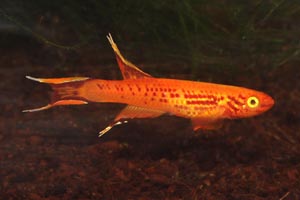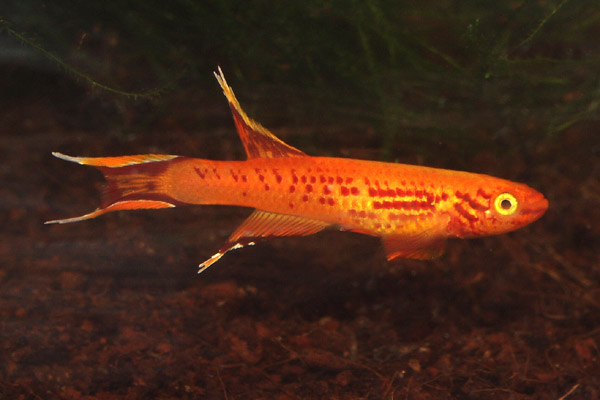

Species Profile | Images | Breeding Report | Similar Species

(Other members of the genus Aphyosemion)
ADULT SIZE: 6 cm
WATER CONDITIONS: Not critical
TEMPERATURE RANGE: 23-28 C
FOOD: Feed Aphyosemion australe small live-foods and fine grade dried foods. All killifish appreciate livefoods, either living or frozen.
DISTRIBUTION: This species comes from Congo (DRC), Gabon, Angola, Congo (Rep.)
SEXUAL DIFFERENCES: Males are brightly coloured with fin filaments. Females are a pale grey/brown.
AQUARIUM CARE: This is probably the worlds favourite killifish. It is easy to keep (if kept alone or with gentle fish), usually easy to breed, and a stunning addition to a dark well planted aquarium. The most common 'gold' or 'orange' strain is actually a line bred albino, and does not occur in the wild, but what a beautiful fish!
Killifish can be timid, and generally do best in a species tank
BREEDING: An easy mop spawner. This species will also breed in small numbers in a well-planted, well-fed tank. Failure to breed the species is usually a result of too-young parents, rather than environmental factors. Breeding may be easier in softer, more acidic water, but they will breed in most non-extreme conditions
Have you bred Aphyosemion australe? Why not fill in a breeding questionaire?, or examine existing Aphyosemion australe breeding reports
Other members of the genus Aphyosemion
Other killifish species
Other species from Congo (DRC), Gabon, Angola, Congo (Rep.)

The 'gold' strain of Aphyosemion australe
BREEDING: An easy mop spawner. This species will also breed in small numbers in a well-planted, well-fed tank. Failure to breed the species is usually a result of too-young parents, rather than environmental factors. Breeding may be easier in softer, more acidic water, but they will breed in most non-extreme conditions
Have you bred Aphyosemion australe? Why not fill in a breeding questionaire?
This page summarises breeding reports provided by visitors to this site, along with some statistical analysis. Please feel free to contribute - whatever your experience!
| |||||||||
|
| ||||||||
|
| ||||||||
|
| ||||||||
| |||||||||
Remember, each record represents only one persons experience; if you had different results, or used different methods, please share your experiences
| Water conditions: Neutral | Water temperature: 20-23oC |
| Disposition: Active, but not aggresive | Community tank?: Yes, a good community fish |
| Spawning Method: Adult fish removed from tank | Breeding problems: Poor egg production |
| Sex ratio: Almost all males | Breeding difficulty: Average |
| Sucess: | Years Experience: 1 |
| Other Comments: | |
| Date this record created: 13th March 2010 | Breeding date: 2010 |
| Breeder: | Location: |